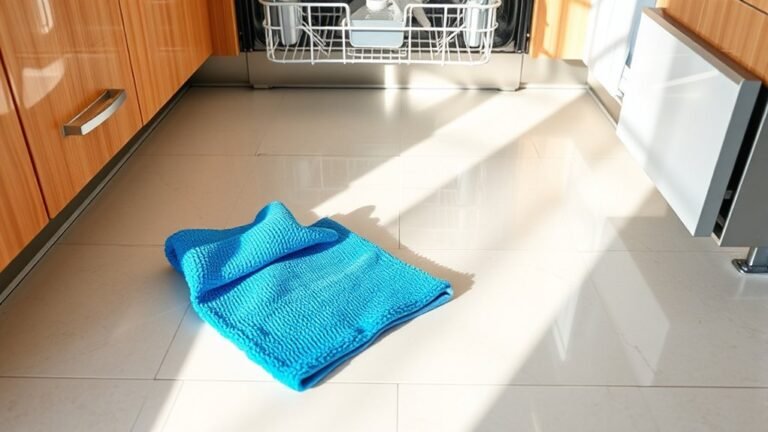Daily Maintenance Tips for Dryer
You should clean the lint filter before every load to prevent airflow restriction and fire risks. Inspect the dryer vent and ductwork regularly for lint buildup and secure connections. Wipe the drum interior with a soft cloth to remove residue and maintain efficiency. Keep the area around the dryer clear to promote safety. Use recommended dryer settings to avoid overloading. Monitor for unusual noises or odors and schedule professional checkups to catch issues early. Explore the following tips to enhance your dryer’s performance and safety.
Check and Clean the Lint Filter

One of the most important steps in dryer maintenance is checking and cleaning the lint filter before every load. You’ll want to remove the lint filter carefully, then use your fingers or a soft brush to clear out accumulated lint. Avoid using water unless the manufacturer specifies it, as moisture can reduce drying efficiency. For stubborn buildup, you can vacuum the filter slot gently. Proper cleaning techniques prevent airflow restriction, which keeps your dryer running efficiently and reduces fire risk. By routinely maintaining the lint filter, you guarantee peak performance and extend your dryer’s lifespan. This simple step gives you the freedom to run your dryer safely and effectively without unexpected breakdowns or hazards. Clean the lint filter diligently—it’s a small task with big benefits.
Inspect the Dryer Vent and Ductwork
Although checking the lint filter is essential, you should also regularly inspect the dryer vent and ductwork to verify proper airflow. Proper ventilation maintenance prevents fire hazards and guarantees efficient drying. When inspecting, focus on:
- Checking for lint buildup inside the vent and ductwork
- Confirming the vent exterior flap opens freely without obstructions
- Ensuring duct connections are secure and airtight
- Looking for any kinks or damage restricting airflow
- Scheduling professional ductwork cleaning at least annually
Neglecting these steps can reduce dryer efficiency and increase energy costs. By maintaining clean, unobstructed ventilation, you’ll extend your dryer’s lifespan and preserve your freedom from costly repairs. Make ductwork cleaning a priority to keep your system operating smoothly and safely.
Wipe Down the Drum Interior

Regularly wiping down the drum interior removes residue, lint, and detergent buildup that can affect drying performance. For effective drum cleaning, use a soft cloth dampened with mild detergent and water. Avoid abrasive materials that could scratch the surface. This interior maintenance prevents odor, reduces wear, and guarantees efficient heat transfer, granting you freedom from frequent repairs.
| Step | Action | Tool Needed |
|---|---|---|
| 1 | Unplug dryer | None |
| 2 | Wipe drum with cloth | Soft cloth |
| 3 | Dry drum surface | Dry microfiber |
Monitor Dryer Performance and Temperature
You should regularly check that your dryer maintains consistent heat throughout each cycle to guarantee efficient drying. Pay attention to any unusual noises that could indicate mechanical issues needing immediate attention. Additionally, inspect the ventilation system to confirm it’s clear and functioning properly, preventing overheating and energy waste.
Check Heat Consistency
When monitoring your dryer’s performance, consistently checking the heat output is essential to confirm efficient operation. Maintaining steady heat efficiency prevents longer drying times and reduces energy waste. You’ll want to watch for temperature fluctuations that signal potential issues in the heating element or thermostat. To effectively check heat consistency:
- Use a handheld infrared thermometer to measure drum temperature during cycles
- Compare readings against manufacturer’s recommended temperature range
- Inspect heating elements visually for damage or wear
- Verify air vents are clear to avoid heat buildup or loss
- Regularly test the thermostat’s response to temperature changes
Listen for Unusual Noises
How can you tell if your dryer is starting to malfunction before it completely breaks down? Pay close attention to any unusual noises during operation. Grinding, squealing, or banging sounds often signal worn drum bearings, loose belts, or motor issues. Regularly listening allows you to detect these problems early, essential for effective dryer maintenance. Addressing noise sources promptly prevents further damage and improves noise reduction, ensuring your appliance runs smoothly and quietly. To monitor performance and temperature accurately, perform these auditory checks when the dryer is running a full cycle. If you notice abnormal sounds, halt use and inspect or call a technician. Staying proactive with noise monitoring safeguards your dryer’s functionality and grants you the freedom to rely on it without unexpected interruptions.
Inspect Ventilation Efficiency
Unusual noises can indicate internal issues, but ventilation efficiency directly impacts your dryer’s performance and safety. To maintain peak operation, regularly inspect your dryer’s ventilation system. Different ventilation types—rigid metal ducts, flexible aluminum, or plastic—affect airflow and heat dissipation. Conduct a thorough airflow analysis by checking:
- Duct length and bends that restrict airflow
- Accumulated lint or debris blocking vents
- Proper sealing of duct joints to prevent leaks
- External vent cap condition ensuring unobstructed exhaust
- Temperature consistency during drying cycles to detect overheating
Keep the Area Around the Dryer Clear
Although it may seem simple, keeping the area around your dryer clear is essential for safe and efficient operation. Proper dryer location minimizes safety hazards like fire risks caused by lint buildup or obstructed airflow. Make sure no items—clothing, boxes, or cleaning supplies—are stored near the dryer, as these can restrict ventilation or ignite from heat. Maintain at least a 3-foot clearance around the dryer to promote ideal airflow and allow easy access for inspection and maintenance. Avoid blocking the dryer’s vent or exhaust outlets, which can reduce efficiency and increase energy consumption. By keeping this space uncluttered, you reduce the chance of overheating and mechanical failure, ultimately extending your dryer’s lifespan and securing your freedom from costly repairs or dangerous incidents.
Use the Correct Dryer Settings

Maintaining proper clearance around your dryer supports effective airflow, which directly impacts drying performance. Using the correct dryer settings is just as critical for maximizing energy efficiency and ensuring peak fabric care. You’ll want to:
- Select temperature settings that match your fabric type to prevent damage.
- Use sensor drying modes to avoid unnecessary energy consumption.
- Opt for lower heat settings for delicate items to maintain their integrity.
- Choose timed drying only when sensor modes aren’t available, keeping cycles as short as possible.
- Regularly consult your garment labels to align dryer settings with fabric requirements.
Schedule Regular Professional Inspections
Since your dryer experiences frequent use and exposure to lint buildup, scheduling regular professional inspections is essential to guarantee its safe and efficient operation. These inspections address the importance of inspections by identifying worn components, verifying vent integrity, and ensuring electrical connections are secure. By investing in the benefits of maintenance, you prevent potential hazards like overheating or fire risks caused by hidden lint accumulation or mechanical failures. Professionals have the expertise and tools to detect issues that routine cleaning might miss, preserving your dryer’s performance and extending its lifespan. Regular inspections also optimize energy efficiency, saving you money and contributing to environmental freedom. Make it a habit to book these check-ups annually or as recommended by your dryer’s manufacturer to maintain safety and reliability without hassle.
Address Unusual Noises or Smells Immediately
If you notice unusual noises, pinpoint their source quickly to prevent further damage. Detect any abnormal odors, as they often indicate electrical or mechanical issues. Don’t delay—schedule repairs promptly to guarantee your dryer operates safely and efficiently.
Identify Noise Sources
Whenever your dryer starts making unusual noises or emitting strange smells, you should immediately identify the source to prevent further damage. Start by inspecting common trouble spots where faulty bearings or loose components often cause problems. Here’s what to check:
- Drum rollers and axles for wear or misalignment
- Idler pulley tension and condition
- Blower wheel for obstructions or damage
- Motor mounts and bearings for excessive play
- Loose screws, bolts, or panels that may vibrate
Detect Unusual Odors
How can you tell when your dryer is signaling a problem through unusual odors? Detecting strange smells early helps you pinpoint odor sources and implement effective smell prevention measures. You need to regularly sniff near the dryer vent and drum after cycles.
| Odor Type | Likely Cause |
|---|---|
| Burning rubber | Worn belt or pulley |
| Musty/mildew | Moisture buildup, clogged vent |
| Electrical smell | Overheating motor or wiring issue |
| Chemical odor | Residue from detergents or fabric softeners |
| Gas smell | Gas leak (for gas dryers) |
Address these odors immediately to maintain safety and performance. Your prompt attention prevents damage, ensuring your freedom to use your dryer reliably.
Schedule Prompt Repairs
Because unusual noises or smells often indicate underlying mechanical or electrical issues, you should schedule repairs promptly to prevent further damage. Ignoring these signs increases repair frequency and repair costs over time. Acting quickly preserves your dryer’s efficiency and extends its lifespan. When you notice a problem, consider these key steps:
- Turn off the dryer immediately to avoid hazards.
- Inspect for visible signs like burnt wires or worn belts.
- Contact a certified technician for a thorough diagnosis.
- Request an estimate to gauge repair costs before proceeding.
- Maintain a repair log to track frequency and issues for future reference.
Frequently Asked Questions
Can I Use Dryer Sheets With All Types of Dryers?
You can use dryer sheets with most traditional dryers, as they offer benefits like reducing static and adding fragrance. However, for high-efficiency or sensor dryers, dryer sheets might leave residue affecting performance. If you want freedom from potential buildup, consider dryer sheet alternatives such as wool dryer balls or reusable silicone sheets. These options maintain your clothes’ quality while preventing static without compromising your dryer’s sensors or efficiency.
How Often Should I Replace My Dryer’S Belt?
You should replace your dryer’s belt when you notice clear signs of belt wear, such as fraying, cracking, or slipping during operation. Typically, belts last several years, but frequent use or overloading shortens their life. Inspect the belt every 6-12 months to catch replacement signs early. Waiting too long risks dryer malfunction or motor strain. Staying proactive guarantees your dryer runs smoothly, giving you freedom from unexpected breakdowns.
Is It Safe to Run the Dryer Overnight?
Running your dryer overnight can be like playing with fire in a thunderstorm—risky and best avoided. For dryer safety, it’s vital to never leave it unattended for extended periods. While overnight usage might seem convenient, dryers can overheat or cause lint buildup, increasing fire hazards. To protect your freedom and home, always monitor your dryer during operation and guarantee regular maintenance, like cleaning the lint filter and vent, to minimize risks.
What Causes Clothes to Shrink in the Dryer?
Clothes shrink in the dryer mainly due to high heat settings interacting with certain fabric types, like cotton or wool. When exposed to excessive heat, fibers contract, causing shrinkage. To avoid this, you should always check fabric care labels and use low or medium heat settings for delicate materials. Understanding fabric-specific drying needs gives you control, helping you keep your clothes fitting just right without sacrificing convenience or freedom in your laundry routine.
Can I Dry Sneakers in a Standard Dryer?
Back in the days of the Wild West, you’d never dream of tossing sneakers in a standard dryer. Today, you can, but you’ve gotta be careful with sneaker drying. Use low heat or air fluff dryer settings to prevent damage or warping. Avoid high heat, which can ruin the glue and materials. Also, remove insoles and loosen laces first to guarantee thorough drying and maintain your sneakers’ shape and longevity.






